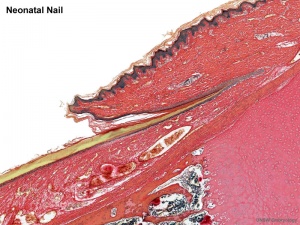Integumentary System - Nail Development: Difference between revisions
From Embryology
| Line 11: | Line 11: | ||
| | | | ||
* '''Incomplete development of the nail of the hallux in the newborn.'''<ref><pubmed>20579456</pubmed></ref> "Between March and October 2008, the nails of 541 (252 females, 289 males) consecutively born neonates with an average age of 3.2 days were examined in the Neonatology Unit. Of these newborns with nail disorders, 36 were re-examined after a period that ranged from seven days to six months. The most frequent nail alteration was the incomplete development of the hallux nail, which was triangular - sometimes trapezoidal - shaped. This alteration, which had been previously reported in the literature as congenital hypertrophy of the lateral folds of the hallux, spontaneously regressed within one to three months in the infants re-examined. There was no associated inflammation or onychocryptosis at any time. The apparent hypertrophy of the nail folds seemed to be secondary to the lack of pressure of the nail lamina." | * '''Incomplete development of the nail of the hallux in the newborn.'''<ref><pubmed>20579456</pubmed></ref> "Between March and October 2008, the nails of 541 (252 females, 289 males) consecutively born neonates with an average age of 3.2 days were examined in the Neonatology Unit. Of these newborns with nail disorders, 36 were re-examined after a period that ranged from seven days to six months. The most frequent nail alteration was the incomplete development of the hallux nail, which was triangular - sometimes trapezoidal - shaped. This alteration, which had been previously reported in the literature as congenital hypertrophy of the lateral folds of the hallux, spontaneously regressed within one to three months in the infants re-examined. There was no associated inflammation or onychocryptosis at any time. The apparent hypertrophy of the nail folds seemed to be secondary to the lack of pressure of the nail lamina." | ||
* '''Lyonization pattern of normal human nails.'''<ref><pubmed>18429815</pubmed></ref> "To examine the X-inactivation patterns of normal human nails, we performed the human androgen receptor gene assay of DNA samples extracted separately from each finger and toe nail plates of nine female volunteers. The X-inactivation pattern of each nail was unique and constant for at least 2 years. ...These findings suggest that the composition of precursor cells of each nail is maintained at each site at least through several cycles of regeneration time, and that the nail plate has a longitudinal band pattern, each band consisting of cells with only one of the two X-chromosomes inactivated." | |||
|} | |} | ||
Revision as of 00:13, 21 September 2010
Notice - Mark Hill
Currently this page is only a template and is being updated (this notice removed when completed).Introduction
Some Recent Findings
|
Textbooks
- Human Embryology (2nd ed.) Larson Chapter 14 p443-455
- The Developing Human: Clinically Oriented Embryology (6th ed.) Moore and Persaud Chapter 20: P513-529
- Before We Are Born (5th ed.) Moore and Persaud Chapter 21: P481-496
- Essentials of Human Embryology Larson Chapter 14: P303-315
- Human Embryology, Fitzgerald and Fitzgerald
- Color Atlas of Clinical Embryology Moore Persaud and Shiota Chapter 15: p231-236
Development Overview
- Forelimb before hindlimb - week 10 fingernails, week 14 toe nails
- nail field - appears at tip and migrates to dorsal surface
- thickened epidermis - surrounding cells form nail fold
- keratinization of proximal nail fold forms nail plate
Nails reach Digit Tip
- week 32 fingernails
- week 36 toenails
- nail growth indicator of prematurity
Abnormalities
Nail-patella syndrome
References
Journals
Reviews
Articles
Search PubMed
Search Pubmed: Nail Development
Additional Images
Terms
- nail plate - visible part of the nail
- nail bed - skin beneath the nail plate
- cuticle - tissue that overlaps the plate and rims the base of the nail
- nail folds - skin folds that frame and support the nail on three sides
- lunula - half-moon at the base of the nail
- matrix - hidden part of the nail unit under the cuticle
External Links
Embryo Images - Human (day 64) primary nail fields
Glossary Links
- Glossary: A | B | C | D | E | F | G | H | I | J | K | L | M | N | O | P | Q | R | S | T | U | V | W | X | Y | Z | Numbers | Symbols | Term Link
Cite this page: Hill, M.A. (2024, May 4) Embryology Integumentary System - Nail Development. Retrieved from https://embryology.med.unsw.edu.au/embryology/index.php/Integumentary_System_-_Nail_Development
- © Dr Mark Hill 2024, UNSW Embryology ISBN: 978 0 7334 2609 4 - UNSW CRICOS Provider Code No. 00098G
